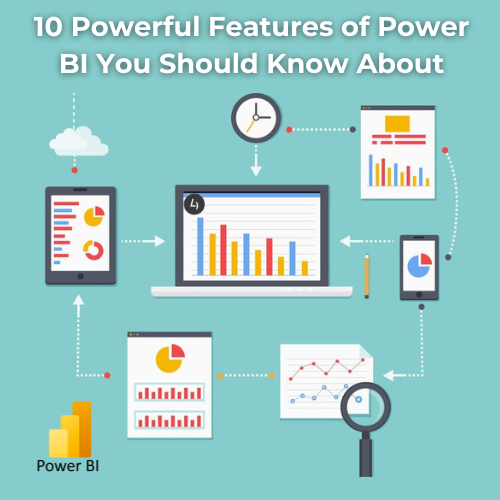Top 10 Power BI Features You Can’t Miss
Power BI, Microsoft’s flagship business analytics tool, has become indispensable for organizations looking to harness the power of their data. With its comprehensive suite of features, Power BI enables businesses to create insightful visualizations, generate reports, and drive data-driven decisions. Whether you’re an experienced analyst or just starting, mastering these key features will help you unlock the full potential of Power BI.
In this blog, we’ll explore 10 powerful features of Power BI that can streamline your data analysis and enhance the value of your reporting. Let’s dive in!
1. Extensive Data Connectivity Options
One of Power BI’s strongest features is its ability to connect to a wide variety of data sources. From cloud platforms like Azure, Salesforce, and Google Analytics to on-premises databases like SQL Server and Excel, Power BI offers seamless integration with virtually any data source.
Why It Matters:
This broad connectivity allows organizations to consolidate and analyze data from disparate systems, providing a comprehensive view that supports better decision-making. You no longer need to switch between multiple platforms to gather insights.
2. Interactive Dashboards and Reports
Power BI empowers users to create interactive dashboards and reports that allow data exploration. Users can drill down into specific data points, apply filters, and interact with visualizations to uncover deeper insights.
Why It Matters:
This interactivity promotes a more engaging user experience. Instead of static reports, users can explore the data dynamically, making it easier to identify trends, patterns, and anomalies as they emerge.
3. Advanced Data Modeling with DAX
DAX (Data Analysis Expressions) is the formula language used in Power BI to perform custom calculations and create sophisticated data models. With DAX, users can define measures, columns, and complex aggregations that go beyond simple data summaries.
Why It Matters:
DAX opens up a world of possibilities for data analysis, enabling you to create tailored metrics and KPIs that suit your specific business needs. This feature allows for highly advanced data modelling and analysis, giving you more control over how data is presented and interpreted.
4. Power Query for Data Transformation
Power Query is a powerful tool within Power BI that facilitates data transformation. Whether you need to clean, filter, or shape your data, Power Query has an intuitive and user-friendly interface that allows you to perform these tasks.
Why It Matters:
Data preparation often takes up a significant portion of the analytics process. Power Query simplifies this by automating many of the data cleaning and transformation tasks, saving you time and ensuring that your data is accurate and ready for analysis.
5. Custom Visualizations for Tailored Insights
While Power BI provides a variety of pre-built visualizations (bar charts, pie charts, line graphs, etc.), it also allows users to create custom visuals or download them from the Microsoft AppSource marketplace. This flexibility enables you to present your data in ways that are best suited to your business needs.
Why It Matters:
Custom visualizations provide an opportunity to represent complex data in a more intuitive or meaningful way. This flexibility is especially important when communicating insights to non-technical stakeholders or when you need specialized visuals for specific use cases.
6. Row-Level Security (RLS) for Data Protection
Row-level security (RLS) is a critical feature for organizations that need to control who can access specific data within Power BI reports. With RLS, users can be granted access to different subsets of data based on their roles, ensuring that sensitive information is only visible to authorized users.
Why It Matters:
RLS enhances data security and ensures compliance with data privacy regulations. It allows businesses to safeguard sensitive information while providing a tailored experience for different users, making it ideal for large organizations or industries with strict security needs.
7. Real-Time Data Streaming
Power BI’s ability to support real-time data streaming is a game-changer for businesses that need up-to-the-minute insights. Whether it’s monitoring social media mentions, tracking sales performance, or observing sensor data, Power BI can integrate with live data streams and provide real-time visualizations.
Why It Matters:
Real-time data streaming enables businesses to react quickly to changing conditions. This is especially valuable in industries like e-commerce, finance, and manufacturing, where decisions need to be made on the fly based on the most current data available.
8. Natural Language Query (Q&A)
The Q&A feature in Power BI allows users to interact with their data using plain language. For example, you can simply type “What was our revenue last quarter?” and Power BI will generate a visualization that answers the question.
Why It Matters:
The Q&A feature lowers the barrier for non-technical users by allowing them to ask questions about their data without needing to understand complex data structures or reporting tools. It makes data exploration more accessible to everyone in the organization.
9. Power BI Mobile App for On-the-Go Insights
Power BI’s mobile app allows users to access their reports and dashboards on smartphones and tablets. This app ensures that users can view real-time data and stay connected to their KPIs from anywhere, whether they’re in the office, on the road, or working remotely.
Why It Matters:
The mobile app provides unmatched flexibility, allowing business leaders and team members to make data-driven decisions even when they’re not at their desk. It’s an essential feature for organizations with a mobile workforce or those that require constant access to data.
10. Seamless Integration with Microsoft Tools
Power BI integrates seamlessly with other Microsoft products, such as Excel, Teams, SharePoint, and Azure. This integration ensures that users can easily embed Power BI reports in Excel, collaborate in Teams, or analyze data from Azure databases directly within Power BI.
Why It Matters:
For businesses already using the Microsoft ecosystem, this integration eliminates the need to switch between different applications. It enhances collaboration, streamlines workflows, and provides a cohesive experience across platforms.
Conclusion
Power BI is a comprehensive and powerful business intelligence platform that helps organisations transform raw data into actionable insights. Its wide range of features—ranging from seamless data connectivity and real-time analytics to advanced modelling and custom visuals—makes it a go-to solution for businesses of all sizes.
By understanding and utilizing these 10 key features, you can significantly enhance your Power BI experience, improve your data analysis capabilities, and drive better business outcomes. Start exploring these features today, and take full advantage of what Power BI has to offer!


